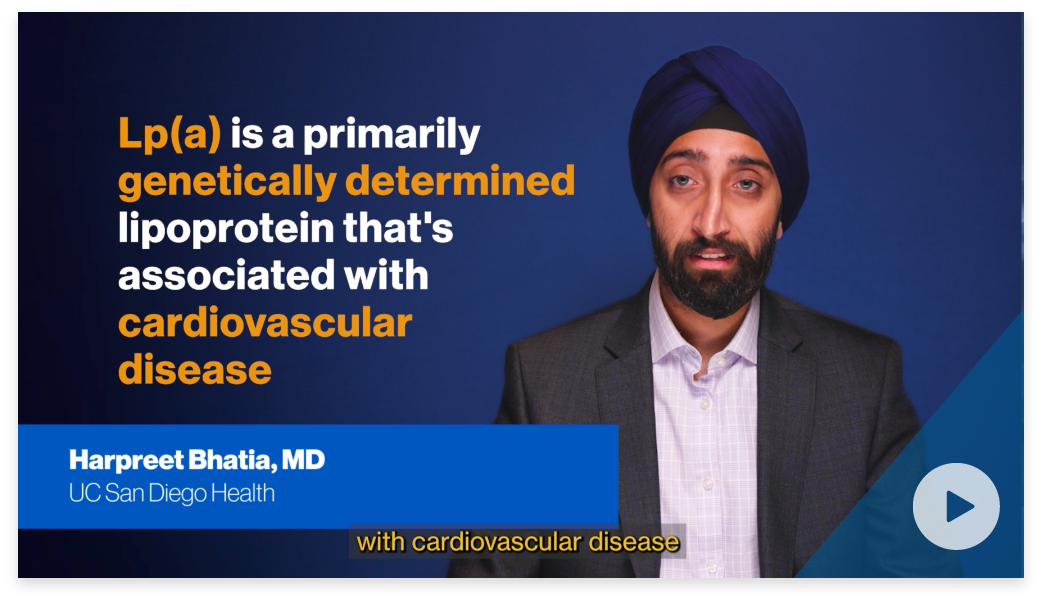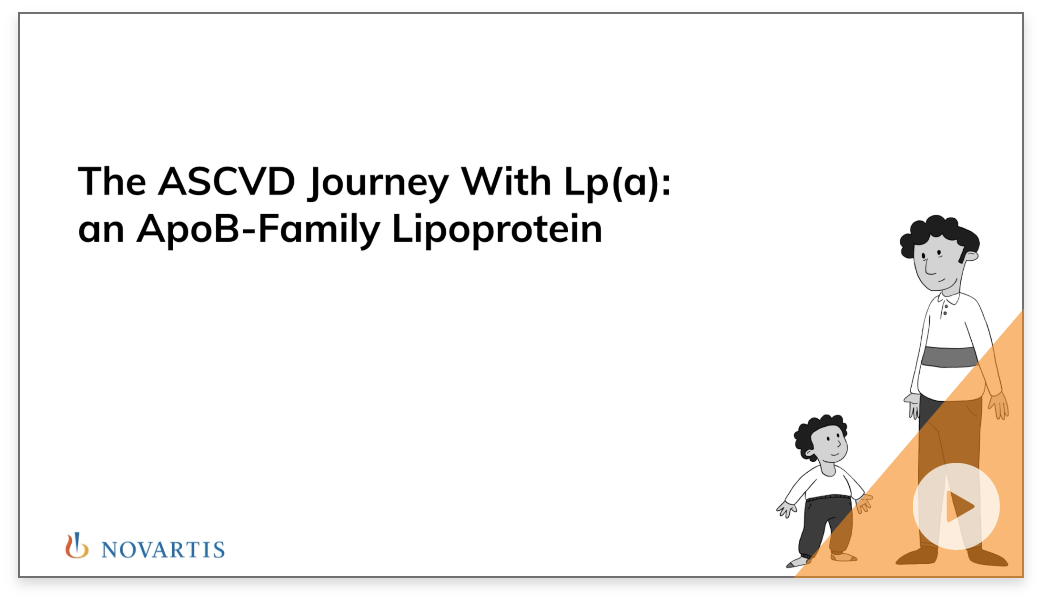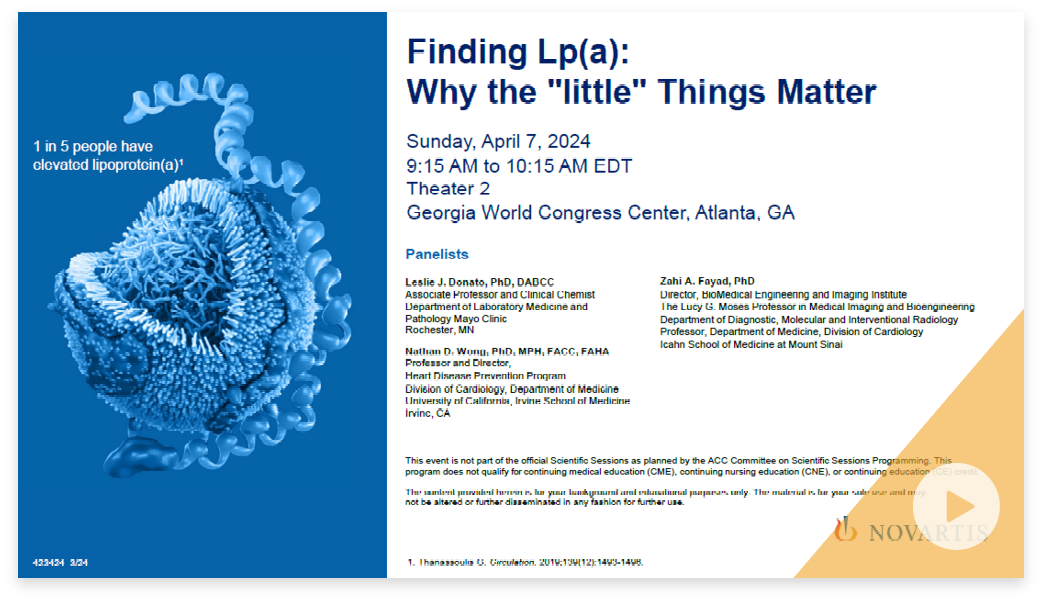Sponsored by Novartis US Medical Affairs
Learn About Lp(a)
Elevated lipoprotein(a) (Lp[a]) represents the most common type of genetic dyslipidemia.1 Elevated Lp(a) levels occurring in 20% of the general population, particularly in certain races and ethnicities.2 More than 70 million people in North America and 1.5 billion people globally are affected.2,3
Lp(a) is the only apo(a)-containing lipoprotein.4 Elevated Lp(a) is an independent, genetic, and causal risk driver of atherosclerotic cardiovascular disease (ASCVD).1,3-5 Elevated Lp(a) levels remain a risk driver for ASCVD development even when plasma low- density lipoprotein cholesterol (LDL-C) levels have been reduced.4 Moreover, patients with elevated Lp(a) levels likely have family members with elevated levels.6,7 Elevated Lp(a) is also an independent predictor of premature ASCVD. US and global consensus statements and guidelines for Lp(a) recommend various patient types be screened/tested for elevated Lp(a).1,6-10 In 2018, two International Statistical Classification of Diseases, Tenth Revision (ICD-10) codes to justify Lp(a) testing were added: E78.41, Elevated Lp(a); and Z83.430, Family history of elevated Lp(a).6,11
CHOOSE A TOPIC
PATIENT VOICES
The content provided herein contains patient opinions. These individuals were offered and may have received compensation from Novartis Pharmaceuticals Corporation.

Patient Heart Health Testimony

Letters from the Heart

Lp(a) Awareness
LISTEN TO THE EXPERTS
The content provided herein contains medical expert opinions. The presenters were offered and may have received compensation from Novartis Pharmaceuticals Corporation.

AHA - Lp(a) Montage

Dr. Libby Discusses Lp(a)

Arthur Gianelli, MA, MBA, MPH on Lp(a)
ACADEMIC RESOURCES
The content provided herein is for your background and educational purposes only. The material is for your sole use and may not be altered or further disseminated in any fashion.

The ASCVD Journey With Lp(a): an ApoB-Family Lipoprotein

Understanding Lp(a): Clinical Implications of an Underrecognized Genetic Dyslipidemia

Finding Lp(a): Why the 'little' Things Matter
References
- Handelsman Y, Jellinger PS, Guerin CK, et al. Consensus statement by the American Association of Clinical Endocrinologists and American College of Endocrinology on the Management of Dyslipidemia and Prevention of Cardiovascular Disease Algorithm – 2020 executive summary. Endocr Pract. 2020;26(10):1196-1224. doi:10.4158/CS-2020-0490
- Tsimikas S, Marcovina SM. Ancestry, lipoprotein(a), and cardiovascular risk thresholds: JACC review topic of the week. J Am Coll Cardiol. 2022;80(9):934-946. doi:10.1016/j.jacc.2022.06.019
- Tsimikas S, Fazio S, Ferdinand KC, et al. NHLBI Working Group recommendations to reduce lipoprotein(a)-mediated risk of cardiovascular disease and aortic stenosis. J Am Coll Cardiol. 2018;71(2):177-192. doi:10.1016/j.jacc.2017.11.014
- Reyes-Soffer G, Ginsberg HN, Berglund L, et al; American Heart Association Council on Arteriosclerosis, Thrombosis and Vascular Biology; Council on Cardiovascular Radiology and Intervention; and Council on Peripheral Vascular Disease. Lipoprotein(a): a genetically determined, causal, and prevalent risk factor for atherosclerotic cardiovascular disease: a scientific statement from the American Heart Association. Arterioscler Thromb Vasc Biol. 2022;42(1):e48-e60. doi:10.1161/ATV.0000000000000147
- Thanassoulis G. Screening for high lipoprotein(a). Circulation. 2019;139(12):1493-1496. doi:10.1161/CIRCULATIONAHA.119.038989
- Wilson DP, Jacobson TA, Jones PH, et al. Use of lipoprotein(a) in clinical practice: a biomarker whose time has come. A scientific statement from the National Lipid Association. J Clin Lipidol. 2019;13(3):374-392. doi:10.1016/j.jacl.2019.04.010
- Kronenberg F, Mora S, Stroes ESG, et al. Lipoprotein(a) in atherosclerotic cardiovascular disease and aortic stenosis: a European Atherosclerosis Society consensus statement. Eur Heart J. 2022;43(39):3925-3946. doi:10.1093/eurheartj/ehac361
- Grundy SM, Stone NJ, Bailey AL, et al. 2018 AHA/ACC/AACVPR/AAPA/ABC/ACPM/ADA/AGS/APhA/ASPC/NLA/PCNA guideline on the management of blood cholesterol: a report of the American College of Cardiology/American Heart Association Task Force on Clinical Practice Guidelines. Circulation. 2019;139(25):e1082-e1143. doi:10.1161/CIR.0000000000000625
- Pearson GJ, Thanassoulis G, Anderson TJ, et al. 2021 Canadian Cardiovascular Society guidelines for the management of dyslipidemia for the prevention of cardiovascular disease in adults. Can J Cardiol. 2021;37(8):1129-1150. doi:10.1016/j.cjca.2021.03.016
- Writing Committee, Lloyd-Jones DM, Morris PB, et al. 2022 ACC expert consensus decision pathway on the role of nonstatin therapies for LDL-cholesterol lowering in the management of atherosclerotic cardiovascular disease risk: a report of The American College of Cardiology Solution Set Oversight Committee. J Am Coll Cardiol. 2022;80(14):1366-1418. doi:10.1016/j.jacc.2022.07.006
- Engler RJM, Brede E, Villines T, Vernalis MN. Lipoprotein(a) elevation: a new diagnostic code with relevance to service members and veterans. Fed Pract. 2019;36(suppl 7):S19-S31.


